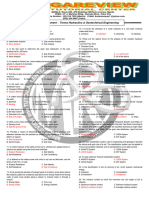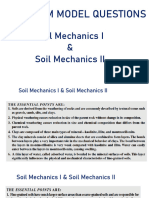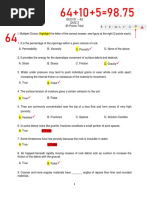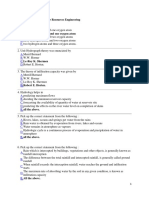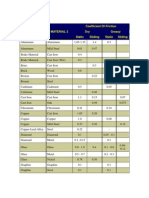0 ratings0% found this document useful (0 votes)
HGE Terms-1
HGE Terms-1
Uploaded by
Mervin RiveraHGE-CE Boards
Copyright:
© All Rights Reserved
Available Formats
Download as DOCX, PDF, TXT or read online from Scribd
Download as docx, pdf, or txt
HGE Terms-1
HGE Terms-1
Uploaded by
Mervin Rivera0 ratings0% found this document useful (0 votes)
HGE-CE Boards
Copyright
© © All Rights Reserved
Available Formats
DOCX, PDF, TXT or read online from Scribd
Share this document
Did you find this document useful?
Is this content inappropriate?
HGE-CE Boards
Copyright:
© All Rights Reserved
Available Formats
Download as DOCX, PDF, TXT or read online from Scribd
Download as docx, pdf, or txt
0 ratings0% found this document useful (0 votes)
HGE Terms-1
HGE Terms-1
Uploaded by
Mervin RiveraHGE-CE Boards
Copyright:
© All Rights Reserved
Available Formats
Download as DOCX, PDF, TXT or read online from Scribd
Download as docx, pdf, or txt
You are on page 1/ 18
OTHER CE TERMS
HYDRAULICS AND PRINCIPLES OF GEOTECHNICAL ENGINEERING
● Cohesive Soil - silt and clay.
● Cohesionless Soil - gravel, sand, stone.
1. Deep groundwater deposits where underground water are available for water supply and
irrigation is known as:
a. Well
b. Water table
c. Aquifers
d. Phreatic table
2. In a fluid flow, if the fluid travels parallel to the adjacent layers and the paths of individual
particles do not cross, the flow is said to be.
a. Laminar
b. Semi
c. Turbulent
d. None of the above
3. A condition of flow characterized when fluid particles move in very irregular paths,
causing an exchange of momentum for portion of the liquid to another is.
a. Laminar
b. Semi
c. Turbulent
d. None of the above
4. A principle of flow measurement which states that the increase in kinetic energy per unit
weight is equal to the decrease in the potential energy per unit weight, is known as:
a. Bernoulli Principle
b. Torricelli Law
c. Energy
d. Paul's Law
5. "The theoretical velocity of a jet of liquid issuing out of an orifice under a head of h being
equal to the velocity of a free-falling body dropping through a height of h" is known as:
a. Bernoulli Principle
b. Torricelli Law
c. Energy
d. Paul's Law
6. The difference between the hydraulic grade line and energy grade line is.
a. Velocity Head
b. Energy head
c. Pressure head
d. Hydraulic head
7. A type of open channel flow where the Froude Number is equal to 1.
a. Critical flow
b. Supercritical flow
c. Subcritical flow
d. Normal Flow
8. It is defined as a conduit in which the liquid flows with a free surface subjected to
atmospheric pressure. The flow is caused by the slope of the conduit and the liquid
surface:
a. Free flow
b. Open channel flow
c. Atmospheric flow
d. Close pipe flow
9. It is an overflow structure built across an open channel for the purpose of measuring or
controlling the flow.
a. Orifice
b. Wire
c. Weir
d. Orifierce
10. Is the test used to determine the grain size distribution of the soils passing the No. 200
sieve.
a. Hydrometer Analysis
b. Sieve Analysis
c. Size Analysis
d. Soil Analysis
11. It is the grain size corresponding to 10 percent passing on a grain-size distribution
curve.
a. Hazen's Effective Size
b. Paul's Effective Size
c. Darcy's Effective Size
d. William's Effective Size
12. Is the ratio of the difference between the void ratios of a cohesionless soil in its loosest
state and existing natural state to the difference between its void ratio in the loosest and
densest states
e. Relative Strength
f. Suitability
g. Relative density
h. Voidibility
13. Provides a means of describing the degree and kind of cohesion and adhesion between
the soil particles as related to the resistance of the soil to deform or rupture.
a. Relative Strength
b. Soil Suitability
c. Relative Density
d. Soil Consistency
14. It is a field measure of the ability of the soil to withstand applied stress or pressure as
applied using the thumb and forefinger.
a. Fingering Resistance
b. Rupture Resistance
c. Thumb Resistance
d. None of the Above
15. Is the attraction of one water molecule to another resulting from hydrogen bonding
(water-water bon,
a. Adhesion
b. Cohesion
c. Interhesion
d. Intrahesion
16. It involves the attraction of a water molecule to a non-water molecule (water-solid bon.
a. Adhesion
b. Cohesion
c. Interhesion
d. Intrahesion
17. The capacity of soil to adhere to other objects. It is estimated at moisture content that
displays maximum adherence between thumb and forefinger.
a. Adhesion
b. Stickiness
c. Cohesion
d. Bonding
18. Degree a soil can be molded or reworked causing permanent deformation without
rupturing.
a. Plastic limit
b. Shrinkage Limit
c. Plasticity
d. Liquid limit
19. Is defined as the moisture content at which soil begins to behave as a liquid material and
begins to flow.
a. Plastic limit
b. Shrinkage Limit
c. Plasticity
d. Liquid limit
20. Is defined as the moisture content at which soil begins to behave as a plastic material: It
is also defined as the moisture content at which the soil crumbles when rolled into a
thread of 3.18 mm in diameter.
a. Plastic limit
b. Plasticity.
c. Shrinkage Limit
d. Liquid limit
21. Is defined as the moisture content at which no further volume change occurs with further
reduction in moisture content.
a. Plastic limit
b. Plasticity
c. Shrinkage Limit
d. Liquid limit
22. Is the densification of soil by removal of air, which requires mechanical energy.
a. Compaction
b. Shrinkage
c. Densification
d. Consolidation
23. The moisture content at which the maximum dry unit weight of soil is attained
a. Extreme Moisture Content
b. Mega Moisture Content
c. Maximum Moisture Content
d. Optimum Moisture Content
24. It is a technique for in situ densification of thick layers of loose granular soil deposits.
a. Compaction
b. Vibroflotation
c. Densification
d. Vibration
25. A line along which water particle will travel from upstream to the downstream side in the
permeable soil medium.
a. Level line
b. Particle line
c. Flow line
d. Travel line
26. A line along which the potential head at all points are equal.
a. Equipotential Line
b. Equinormal line
c. Potential line
d. NOTA
27. They are constructed to calculate the groundwater flow in the media that combine flow
line and equipotential lines.
a. Fish Net
b. Flow Nets
c. Ground Flow Net
28. The sum of the vertical components of the forces developed at the points of contact of
the solid particles per unit cross sectional area of the soil mass.
a. Total Stress
b. Partial Stress
c. Effective Stress
d. Maximum Stress
29. Caused by the elastic deformation of dry soil and of moist and saturated soils without
any change in the moisture content.
a. Immediate settlement
b. Primary consolidation settlement
c. Secondary consolidation settlement
d. Tertiary Consolidation settlement
30. The result of volume change in saturated cohesive soils because of the expulsion of
water that occupies the void spaces.
a. Immediate settlement
b. Primary consolidation settlement
c. Secondary consolidation settlement
d. Tertiary Consolidation settlement
31. The result of the plastic adjustment of soil fabrics.
a. Immediate. settlement
b. Primary consolidation settlement
c. Secondary consolidation settlement
d. Tertiary Consolidation settlement
32. The internal resistance per unit area of the soil mass to resist failure and sliding along
any plane.
a. Shear strength
b. Effective strength
c. Bearing strength
d. Normal strength
33. Ratio of preconsolidation pressure to present effective overburden pressure.
a. Overconsolidation ratio (OCR)
b. Oversettlement ratio
c. Overburden ratio
d. Overstress ratio
34. An exposed ground surface that stands at an angle with the horizontal. It is a slope that
can either be natural or constructed.
a. Restrained Slope
b. Slope Failure
c. Unrestrained Slope
d. Infinite Slope
35. The process of identifying the layers of deposits that underlie a proposed structure and
their physical characteristics:
a. Geological exploration
b. Geotechnical Exploration
c. Surface Exploration
d. Subsurface Exploration
36. It is a method for analyzing the stability of a slope in two dimensions. The sliding mass
above the failure surface is divided into a number of slices. The forces acting on each
slice are obtained by considering the mechanical equilibrium for the slice surface is
divided into a number of slices. The forces acting on each slice are obtained by
considering the mechanical equilibrium for the slices.
a. Method of Slices
b. Bishop's Simplified Method of Slices
c. Sarma Method
d. Lorimer's Method
37. It is a type of failure that occurs in such a way that the surface of sliding passes at a
distance below the toe of the slope.
a. Slope failure
b. Base Failure
c. Circular Failure
d. critical Failure
38. It is a type of failure that occurs in such a way that the surface of sliding intersects the
slope or above its toe.
a. Slope failure
b. Circular Failure
c. Base Failure
d. Critical Failure
39. It is the failure circle in the case of slope and occurs when it passes through the toe of
the slope.
a. Toe Circle
b. Slope Circle
c. Mid-point Circle
d. Concentric Circle
40. It is the failure circle in the case of slope circle and occurred when it passes above the
toe of the slope
a. Toe Circle
b. Mid-point Circle
c. Slope Circle
d. Concentric Circle
41. It is the failure circle in the case of base failure.
a. Toe Circle
b. Mid-point Circle
c. Slope Circle
d. Concentric Circle
42. It refers to the condition in which every point in a soil mass is on the verge of failure,
a. Plastic Equilibrium
b. Elastic Equilibrium
c. Dynamic Equilibrium
d. Static Equilibrium
43. It is the pressure that soil exerts against a structure in a sideways, mainly horizontal
direction. The common applications of its theory are for the design of ground engineering
structures such as retaining walls, basements, tunnels, and to determine the friction on
the sides of deep foundations.
a. Allowable pressure
b. Effective Pressure
c. Lateral Earth Pressure
d. Ultimate Pressure
44. The state occurs when a soil mass is allowed to relax or move outward to the point of
reaching the limiting strength of the soil; that is, the soil is at the failure condition in
extension. Thus it is the minimum lateral soil pressure that may be exerted.
a. Active State
b. Passive State
c. Equilibrium State
d. NOTA
45. It is simply an enlargement of a load bearing wall or column that makes it possible to
spread the load of the structure over the large area of the soil.
a. Spread Footing
b. Pile and Drilled Shaft Foundation
c. Mat Foundation
d. Deep Foundation
46. It is a structural member made of concrete, timber, or steel that transmit the load of the
superstructure to the lower layers of the soil.
a. Footing
b. Pile
c. Anchorage
d. Column
47. It is a type of foundation which is referred to as a raft foundation: It is a combined footing
that may cover entire area under structure supporting several columns and walls,
a. Spread Footing
b. Mat Foundation
c. Pile and Drilled Shaft Foundation
d. Deep Foundation
48. He was the first to present a comprehensive theory for evaluating the ultimate bearing
capacity of rough shallow foundation. According to his theory the depth of the foundation
is shallow if the depth of the foundation is less than or equal to the width of the
foundation.
a. Rankine
b. Terzaghi
c. Coulomb
d. Meyorhof
49. He proposed a correlation for the net allowable bearing pressure for foundation with the
standard penetration resistance.
a. Rankine
b. Terzaghi
c. Coulomb
d. Meyorhof
50. It is a type of retaining wall which is constructed with plain concrete or stone masonry.
They depend on their own weight and any soil resting on the masonry for stability and it
is not economical for high walls.
a. Gravity Retaining Wall
b. Cantilever Retaining Wall
c. Semi-Gravity retaining Wall
d. Counterfort Retaining Wall
51. They are made up of reinforced concrete that consist of a thin stem and a base slab.
This type of wall is economical to a height of about 8m.
a. Gravity Retaining Wall
b. Cantilever Retaining Wall
c. Semi-Gravity retaining Wall
d. Counterfort Retaining Wall
52. It is similar to the Cantilever Retaining Wall; its purpose is to reduce the shear and the
bending moments.
a. Gravity Retaining Wall
b. Semi-Gravity retaining Wall
c. Cantilever Retaining Wall
d. Counterfort Retaining Wall
53. It is defined as the ratio of the unconfined compression strength in an undisturbed state
to that in a remolded state.
a. Degree Of Saturation
b. Degree Of Freedom
c. Degree Of Sensitivity
d. Degree Of Compressibility
54. It is another method of determining liquid limit that is popular in Europe and in Asia. In
this test the liquid limit is defined as the moisture content at which a standard cone of
apex angle 300 and weighing 0.78 N will penetrate a distance d=20 mm in 5 seconds
when allowed to drop from a position of point contact with the soil surface.
a. Fall Cone Test
b. Standard Cone Test
c. British Standard Test
d. Europe Cone Test
55. The conditions for the stable equilibrium of a floating body are
a. the metacenter should lie above the center of gravity
b. the center of buoyancy and the center of gravity must lie on the same vertical line
c. a righting couple should be formed
d. all the above
56. Metacentric height is given as the distance between
a. the center of gravity of the body and the metacenter
b. the center of gravity of the body and the center of buoyancy
c. the center of gravity of the body and the center of pressure
d. center of buoyancy and metacenter
57. Metacenter is the point of intersection of
a. vertical upward force through e.g. of body and center line of body
b. buoyant force and the center line of body
c. midpoint between e.g. and center of buoyancy
d. all of the above
58. When a body floating in a liquid, is displaced slightly, it oscillates about
a. c.g. of body
b. center of pressure
c. center of buoyancy
d. metacenter
59. When the ship’s metacenter and center of gravity coincide at same point then the vessel
is said to be in:
a. equilibrium
b. stable equilibrium
c. unstable equilibrium
d. neutral equilibrium
60. The resultant upward pressure of a fluid on a floating body is equal to the weight of the
fluid displaced by the body. This definition is according to
a. Equilibrium of a floating body
b. Archimedes’ principle
c. Bernoulli’s theorem
d. Metacentric principle
61. The resultant upward pressure of the fluid on an immersed body is called
a. Upthrust
b. buoyant force
c. center of pressure
d. all the above
62. What is the principal cause of action of buoyant force on a body submerged partially or
fully in fluid?
a. Displacement of fluid due to submerged body
b. Development of force due to dynamic action
c. Internal shear forces mitigating external forces
d. None of the mentioned
63. The center of gravity of the volume of the liquid displaced by an immersed body is called
a. meta-center
b. center of pressure
c. center of buoyancy
d. center of gravity
64. The horizontal component of buoyant force is
a. Negligible
b. same as buoyant force
c. zero
d. none of the above
65. The line of action of the buoyant force acts through the
a. centroid of the volume of fluid vertically above the body
b. center of the volume of floating body
c. center of gravity of any submerged body
d. centroid of the displaced volume of fluid
66. Choose the wrong statement
a. any weight, floating or immersed in a liquid, is acted upon by a buoyant force
b. Buoyant force is equal to the weight of the liquid displaced
c. The point through which buoyant force acts, is called the center of buoyancy
d. Center of buoyancy is located above the center of gravity of the displaced liquid
67. According to the principle of buoyancy a body totally or partially immersed in a fluid will
be lifted up by a force equal to
a. the weight of the body
b. more than the weight of the body
c. less than the weight of the body
d. weight of the fluid displaced by the body
68. How can relatively denser objects be made to float on the less dense fluid?
a. By altering the shape.
b. By altering the forces acting on the object
c. By altering the shear forces acting on the object
d. None of the mentioned
69. Energy gradient line takes into consideration
a. potential and kinetic heads only
b. potential and pressure heads only
c. kinetic and pressure heads only
d. potential, kinetic and pressure heads
70. Hydraulic gradient line takes into consideration
a. potential and kinetic heads only
b. potential and pressure heads only
c. kinetic and pressure heads only
d. potential, kinetic and pressure heads
71. Which of the following is true?
a. EGL always drops in the direction of flow
b. EGL always rises in the direction of flow
c. EGL always remains constant in the direction of flow
d. EGL may or may not change in the direction of flow
72. Which of the following is true?
a. HGL will never be above EGL
b. HGL will never be under EGL
c. HGL will never coincide with EGL
d. HGL will may or may not be above EGL
73. The vertical intercept between EGL and HGL is equal to
a. pressure head
b. potential head
c. kinetic head
d. Piezometric head
74. The slope of HGL will be
a. greater than that of EGL for a pipe of uniform cross-section
b. smaller than that of EGL for a pipe of uniform cross-section
c. equal than that of EGL for a pipe of uniform cross-section
d. independent of that of EGL for a pipe of uniform cross-section
75. Equation of continuity is based on the principle of conservation of
a. Mass
b. Energy
c. Momentum
d. none of the above
76. Bernoulli equation deals with the law of conservation of
a. Mass
b. Momentum
c. Energy
d. work
77. All the terms of energy in Bernoulli’s equation have dimension of
a. Energy
b. Work
c. Mass
d. Length
78. The losses of energy in pipes due to
a. Friction of surface
b. Sudden enlargement or contraction of area
c. Any obstruction in the path of flow
d. All of these
79. The major loss of energy in long pipes is due to
a. sudden enlargement
b. sudden contraction
c. gradual contraction or enlargement
d. friction
80. Which one of the following is a major loss?
a. frictional loss
b. shock loss
c. entry loss
d. exit loss
81. Minor losses occur due to
a. sudden enlargement in the pipe
b. sudden contraction in the pipe
c. bends in pipe
d. all of the above
82. Minor losses do not make any serious effect in
a. short pipes
b. long pipes
c. both the short as well as long pipes
d. cannot say
83. Fluid is a substance that
a. cannot be subjected to shear forces
b. always expands until it fills any container
c. has the same shear stress at a point regardless of its motion
d. cannot remain at rest under action of any shear force
84. Density of water is maximum at
a. 0°C
b. 4°C
c. 100°C
d. 20°C
85. Property of a fluid by which its own molecules are attracted is called
a. Adhesion
b. Cohesion
c. Viscosity
d. surface tension
86. Property of a fluid by which molecules of different kinds of fluids are attracted to each
other is called
a. adhesion
b. cohesion
c. viscosity
d. surface tension
87. The normal stress in a fluid will be constant in all directions at a point only if
a. it is incompressible
b. it has zero viscosity
c. it is frictionless
d. it is at rest
88. Specific weight of sea water is more that of pure water because it contains
a. dissolved air
b. dissolved salt
c. suspended matter
d. all of the above
89. Free surface of a liquid tends to contract to the smallest possible area due to force of
a. surface tension
b. viscosity
c. friction
d. cohesion
90. A liquid would wet the solid, if adhesion forces as compared to cohesion forces are
a. less
b. more
c. equal
d. less at low temperature and more at high temperature
91. Barometer is used to measure
a. pressure in pipes, channels etc.
b. atmospheric pressure
c. very low pressure
d. difference of pressure between two points
92. Manometer is used to measure
a. pressure in pipes, channels etc.
b. atmospheric pressure
c. very low pressure
d. velocity in pipes
93. If cohesion between molecules of a fluid is greater than adhesion between fluid and
glass, then the free level of fluid in a dipped glass tube will be
a. higher than the surface of liquid
b. the same as the surface of liquid
c. lower than the surface of liquid
d. unpredictable
94. When a fluid is subjected to resistance, it undergoes a volumetric change due to
__________
a. Cohesion
b. Strain
c. Compressibility
d. Adhesion
95. Liquids transmit pressure equally in all the directions. This is according to
a. Boyle’s law
b. Archimedes principle
c. Pascal’s law
d. Newton’s formula
96. The rise or depression of liquid in a tube due to surface tension with an increase in size
of tube will
a. increase
b. remain unaffected
c. may increase or decrease depending on the characteristics of liquid
d. decrease
97. Mercury is often used in barometer because
a. it is the best liquid
b. the height of barometer will be less
c. its vapor pressure is so low that it may be neglected
d. both b and c
98. The point in the immersed body through which the resultant pressure of the liquid may
be taken to act is known as
a. meta center
b. center of pressure
c. center of buoyancy
d. center of gravity
99. Which of the following is the correct relation between centroid (cg) and the center of
pressure (cp) of a plane submerged in a liquid?
a. cg is always below cp
b. cp is always below cg
c. cg is either at cp or below it
d. cp is either at cg or below it
100. The total pressure force on a plane area is equal to the area multiplied by the
intensity of pressure at the centroid, if
a. the area is horizontal
b. the area is vertical
c. the area is inclined
d. all of the above
101. Choose the wrong statement
a. The horizontal component of the hydro-static force on any surface is equal the
normal force on the vertical projection of the surface
b. The horizontal component acts through the center of pressure for the vertical
projection
c. The vertical component of the hydrostatic force on any surface is equal to the
weight of the volume of the liquid above the area
d. The vertical component passes through the center of pressure of the volume
102. Center of pressure on an inclined plane is
a. at the centroid
b. above the centroid
c. below the centroid
d. at metacenter
103. Can center of pressure for a vertical plane submerged surface ever be above
center of gravity
a. Yes
b. No
c. It can be above in cases where the surface height is very large
d. None of the mentioned
104. In a vertically submerged plane surface, pressure at every point remains same
a. True
b. False
105. For an inclined plate the pressure intensity at every point differs.
a. True
b. False
106. The magnitude of total pressure and center of pressure is independent on the
shape of the submerged plane surface.
a. True
b. False
107. What is the variation of total pressure with depth for any submerged surface if we
neglect variation in the density?
a. Linear
b. Parabolic
c. Curvilinear
d. Logarithmic
You might also like
- Geotech Engineering: Er. Sandip BudhathokiNo ratings yetGeotech Engineering: Er. Sandip Budhathoki48 pages
- Hydraulics and Geotechnical Exam Definition of Terms Question by E-MtNo ratings yetHydraulics and Geotechnical Exam Definition of Terms Question by E-Mt5 pages
- Hpge 2010 2022 Compilation of Terms EMTNo ratings yetHpge 2010 2022 Compilation of Terms EMT57 pages
- PANA Crash Course Chapter 2 Soil Mechanics and Foundation Eng.No ratings yetPANA Crash Course Chapter 2 Soil Mechanics and Foundation Eng.109 pages
- Civil Engineering Reviewer - Soil and Foundation100% (4)Civil Engineering Reviewer - Soil and Foundation8 pages
- Geotechnical Engineering Refresher Module PDFNo ratings yetGeotechnical Engineering Refresher Module PDF5 pages
- Structural Design-Part One-Board ProblemsNo ratings yetStructural Design-Part One-Board Problems10 pages
- Basic Civil and Mechanical-unit-3-Pumps and Turbines-SupportNo ratings yetBasic Civil and Mechanical-unit-3-Pumps and Turbines-Support10 pages
- 2.2 Newton'S Laws of Motion: Bridge Course - Phy - I PUC - 40No ratings yet2.2 Newton'S Laws of Motion: Bridge Course - Phy - I PUC - 407 pages
- Optical Communication:: 14. Semiconductor LED and LasersNo ratings yetOptical Communication:: 14. Semiconductor LED and Lasers31 pages
- An Experimental Study of Stone Columns INo ratings yetAn Experimental Study of Stone Columns I4 pages
- Lab Exercise No. 6: Ideal Gas Law: Department of Mechanical EngineeringNo ratings yetLab Exercise No. 6: Ideal Gas Law: Department of Mechanical Engineering3 pages
- Final JR Iit Co Super Chaina Star-II (New) Teaching Schedule - 2023-24 (Code - Christmas)No ratings yetFinal JR Iit Co Super Chaina Star-II (New) Teaching Schedule - 2023-24 (Code - Christmas)20 pages
- The Fiberbond® Engineering Guide: FGKPRIL 2016No ratings yetThe Fiberbond® Engineering Guide: FGKPRIL 201655 pages
- HW Chapter 27 Giancoli Physics SolutionsNo ratings yetHW Chapter 27 Giancoli Physics Solutions13 pages
- Three Dimensional Mos Ns@Au Nps Hybrids As Sers Sensor For Quantitative and Ultrasensitive Detection of Melamine in MilkNo ratings yetThree Dimensional Mos Ns@Au Nps Hybrids As Sers Sensor For Quantitative and Ultrasensitive Detection of Melamine in Milk11 pages
- Ch. 3 Mechanical Behavior of Metallic MaterialsNo ratings yetCh. 3 Mechanical Behavior of Metallic Materials42 pages
- IRTS Pulsed Eddy Current Testing Work ProcedureNo ratings yetIRTS Pulsed Eddy Current Testing Work Procedure10 pages
- School of Physics & Materials Science: Thapar University, PatialaNo ratings yetSchool of Physics & Materials Science: Thapar University, Patiala1 page
- Hydraulics and Geotechnical Exam Definition of Terms Question by E-MtHydraulics and Geotechnical Exam Definition of Terms Question by E-Mt
- PANA Crash Course Chapter 2 Soil Mechanics and Foundation Eng.PANA Crash Course Chapter 2 Soil Mechanics and Foundation Eng.
- Basic Civil and Mechanical-unit-3-Pumps and Turbines-SupportBasic Civil and Mechanical-unit-3-Pumps and Turbines-Support
- 2.2 Newton'S Laws of Motion: Bridge Course - Phy - I PUC - 402.2 Newton'S Laws of Motion: Bridge Course - Phy - I PUC - 40
- Optical Communication:: 14. Semiconductor LED and LasersOptical Communication:: 14. Semiconductor LED and Lasers
- Lab Exercise No. 6: Ideal Gas Law: Department of Mechanical EngineeringLab Exercise No. 6: Ideal Gas Law: Department of Mechanical Engineering
- Final JR Iit Co Super Chaina Star-II (New) Teaching Schedule - 2023-24 (Code - Christmas)Final JR Iit Co Super Chaina Star-II (New) Teaching Schedule - 2023-24 (Code - Christmas)
- Three Dimensional Mos Ns@Au Nps Hybrids As Sers Sensor For Quantitative and Ultrasensitive Detection of Melamine in MilkThree Dimensional Mos Ns@Au Nps Hybrids As Sers Sensor For Quantitative and Ultrasensitive Detection of Melamine in Milk
- School of Physics & Materials Science: Thapar University, PatialaSchool of Physics & Materials Science: Thapar University, Patiala












